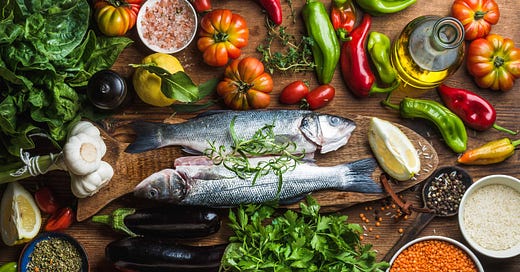Flexible semi-vegan diet that is more like a lifestyle change
Review of VB6: Eat Vegan Before 6:00 to Lose Weight and Restore Your Health . . . for Good by Mark Bittman
I heard Bittman describe his vb6 diet in an interview and knew I had read this book. Though I have never had a weight problem, what interested me most was the health issue and beyond that, environmental sustainability. Bittman’s unique approach addresses all 3 issues. It also allows a degree of diet freedom, in that after 6 pm, you do what you want, what satisfies you – in moderation. During the day, you eat vegan: leafy veg, no milk or animal protein, minimal oils, whole grains. No calorie counting or elimination of entire food categories, no consistent self-deprivation, all of which Bittman sees as ensuring failure in the long run. His goal is moderated satiety rather than deprivation.
At its most basic, vb6 advocates: 1) more plant foods, 2) fewer animal products, 3) the elimination of junk foods (with the exception of an occasional indulgence). A corollary is that we should prefer lesser processed foods, which tend to strip the fibers as well as healthier (more slowly digested) forms of carbohydrates.
Bittman emphasizes 4 nutrition themes: 1) you won’t lose weight permanently by limiting calorie intake; 2) some foods are “calorie bombs” that should be avoided, such as fructose; 3) the body treats different foods differently; 4) real food is better than hyper-processed foods.
In practical terms, this means that the amount you eat is less important than the kinds of food you eat. To explain this, Bittman gets into some basic nutritional science. The body is seeking sources of energy to fuel and maintain the body. Carbohydrates, fats and proteins (macronutrients) are the principal forms. They enter the blood stream and are broken down. If they are absorbed too quickly, as the hyper-processed foods tend to be (e.g. white flour, candy bars, cheerios), you tend to get hungry more often, hence you will eat more and will store more fat. In contrast, those that break down more slowly (vegetables, whole grains, lightly processed legumes) will sustain you longer without the need to snack. Bittman’s argument is of course much more complex and nuanced than this, but that is the gist.
The details are very important and informative. For example, the fructose (corn sugars) in most sodas act differently than sugars in fruits: rather than converting to glucose, it goes straight to the liver, which bypasses the insulin production that would signal that the body has enough carbohydrate energy. Bittman’s remedy: eat fruit and drink water instead of soda. Starch in white flower is similar to fructose and should be replaced by whole grains when possible. Animal and junk-food fats are the same, i.e. worse than those in nuts and grains, olive oil, and vegetables. There are many useful charts in the book.
Along the way, Bittman emphasizes some basic facts. He acknowledges the “metabolism” argument is seductive – different people gain weight at different rates due to some predisposition, genetic or otherwise – but concludes that it is largely unsupported by scientific research. He believes in a simpler formula. If you eat more calories than you burn as energy, you will gain weight. I would put it more simply: if you eat too much, you will get fat. “The key word here,” he writes, “is balance”. (I love the simplicity and clarity of his writing.)
The rest of the book offers strategies and recipes. I will try them more systematically than I have applied them in my cooking habits. Recommended.



